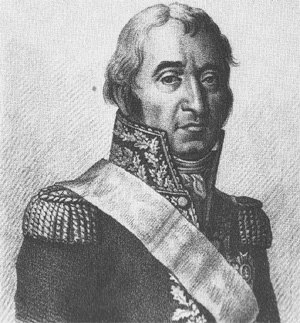General François Chasseloup-Laubat

Born: August 18, 1754
Place of Birth: Saint-Sornin, Charente-Maritime, France
Died: October 6, 1833
Place of Death: Paris, France
Arc de Triomphe: CHASSELOUP-AT on the south pillar
Pronunciation:
Of noble birth, François Chasseloup-Laubat initially joined the artillery in 1770 before attending the artillery school of Mézières in 1778. He served as a lieutenant until the Revolution arrived and he was finally promoted to capitaine in 1791. Assigned to the Army of the Center, Chasseloup-Laubat battled before Gevint and then directed the defense of Montmédy and Longway. In 1793 he served at Arlon, was promoted to chef de bataillon, and was placed with the Army of the Moselle. The next year Chasseloup-Laubat again served at Arlon and then joined the Army of the Sambre and Meuse, serving during the siege of Maestricht. A promotion to chef de brigade followed and then in 1795 he served at the siege of Mainz.
In 1796 Chasseloup-Laubat joined General Bonaparte's Army of Italy. That May he directed the engineers for the crossing of the Po, and then in June he was named commander-in-chief of the engineers of the Army of Italy. Chasseloup-Laubat went on to serve at Lonato , Castiglione , Roveredo, Arcola , and Rivoli during that campaign. Afterwards, he was promoted to général de brigade and then sent to Paris on a mission.
In February of 1798 Chasseloup-Laubat was named director of fortifications and ordered to survey and direct the fortifications of the eastern frontier of France along the Rhine. That September he returned to Paris and then he was sent to Italy to command the engineers there. In 1799 Chasseloup-Laubat was allowed to leave the army to recover from illness, and after he returned he was promoted to général de division. In 1800 he briefly commanded the engineers of the Army of the Reserve before taking command of the engineers of the Army of Italy again. The following year Chasseloup-Laubat directed the siege of Peschiera and forced its surrender.
During the years of peace that followed, Chasseloup-Laubat traveled around Italy, demolishing some of the fortifications there while improving the fortifications of other locations. He was named a Commander of the Iron Crown in 1805, and then when war broke out that year he took command of the engineers of the Army of Italy under Marshal Masséna. During that campaign, he served at the action of the bridge at Verona.
The next year Chasseloup-Laubat traveled to Holland where Napoleon named him commander-in-chief of the engineers of the Grande Armée. In such an important position, he became known for the ability to do trigonometry in his head and being calm and quiet until discovering sloppy workmanship from his engineers.1 Chasseloup-Laubat took part in the campaigns of 1806 and 1807, serving at Golymin and Eylau before directing the Siege of Danzig . After Danzig was taken, Chasseloup-Laubat next directed the siege of Stralsund. In 1808 he was sent back to Italy to direct the fortifications there and he was also named a Count of the Empire. When war again broke out against Austria in 1809, Chasseloup-Laubat was named commander-in-chief of the engineers of the Army of Italy.
1811 saw Chasseloup-Laubat traveling to Cherbourg and Holland and being named a Councilor of State. The next year he became commander-in-chief of the engineers of the Grande Armée for the campaign in Russia, and during the retreat he served notably at the Berezina. After that campaign, in 1813 Chasseloup-Laubat became a senator and retired from the military. He was given the Grand Cross of the Order of the Reunion in recognition of his services.
In 1814 Chasseloup-Laubat was briefly ordered back into military service to survey and direct the defense of many of the bridges along the Loire. After Napoleon's abdication, Chasseloup-Laubat was named a Peer of France and given the Grand Cross of the Legion of Honor by the returning Bourbons. When Napoleon escaped from Elba in 1815 for the Hundred Days, Chasseloup-Laubat kept away from Paris and did not participate. Once the Bourbons were again restored to the throne, he participated in the trial of Marshal Ney where he voted for deportation.
Notes
Bibliography
Updated April 2019
© Nathan D. Jensen